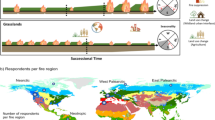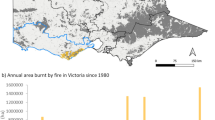
Overview
- Features new theoretical ideas, new syntheses, and a broad sampling of field landscape ecology
- Focus on applications of theoretical concepts in landscape and fire ecology
- Covering policy and management implications of increased fire disturbance
- Includes supplementary material: sn.pub/extras
Part of the book series: Ecological Studies (ECOLSTUD, volume 213)
Access this book
Tax calculation will be finalised at checkout
Other ways to access
About this book
Similar content being viewed by others
Keywords
Table of contents (12 chapters)
-
Front Matter
-
Concepts and Theory
-
Front Matter
-
-
Landscape Fire Dynamics and Interactions
-
Front Matter
-
-
Landscape Fire Management, Policy, and Research in an Era of Global Change
-
Front Matter
-
-
Back Matter
Reviews
From the reviews:
“This work represents the state of the art in North American landscape fire ecology. Integrating geospatial technologies with landscape ecology, the book presents the advanced student, practitioner, or researcher of fire management, landscape ecology, and climate change with conceptual frameworks, theory, and examples of data-driven analyses in multiple regions. … Valuable as a reference for land managers of fire-dependent ecosystems, and as a point of departure for graduate research. Summing Up: Highly recommended. Upper-division undergraduate through professional readership.” (E. J. Delaney, Choice, Vol. 48 (11), August, 2011)
“This volume addresses several emerging ideas regarding the landscape ecology of fire, consisting of 12 collected chapters. … it aims to advance certain emerging subfields and theories that are less covered in other publications. In this way much of the work is quite interesting and useful … . this volume complements other fireecology works well and ultimately achieves its objective of advancing thought on some promising new landscape disturbance theories and key contemporary topics.” (Daniel C. Donato, The Quarterly Review of Biology, Vol. 88 (1), March, 2013)
Editors and Affiliations
Bibliographic Information
Book Title: The Landscape Ecology of Fire
Editors: Donald McKenzie, Carol Miller, Donald A. Falk
Series Title: Ecological Studies
DOI: https://doi.org/10.1007/978-94-007-0301-8
Publisher: Springer Dordrecht
eBook Packages: Biomedical and Life Sciences, Biomedical and Life Sciences (R0)
Copyright Information: Springer Science+Business Media B.V. 2011
Hardcover ISBN: 978-94-007-0300-1Published: 06 January 2011
Softcover ISBN: 978-94-007-3481-4Published: 27 February 2013
eBook ISBN: 978-94-007-0301-8Published: 04 January 2011
Series ISSN: 0070-8356
Series E-ISSN: 2196-971X
Edition Number: 1
Number of Pages: XX, 312
Topics: Landscape Ecology, Theoretical Ecology/Statistics, Climate Change, Geoecology/Natural Processes, Terrestial Ecology



